Research Proposal: Health Concerns/Challenges Facing Pregnant Mothers
VerifiedAdded on 2022/11/03
|7
|1627
|449
Report
AI Summary
This research proposal investigates the health concerns and challenges faced by pregnant mothers in the Wheat Belt region of West Australia. The study highlights the inadequacy of current maternal healthcare services, focusing on limited access to birthing facilities and the prevalence of health issues like anemia, high blood pressure, and gestational diabetes. The research aims to assess antenatal care, identify challenges to successful pregnancies, and develop a conceptual framework for future interventions. The methodology involves a qualitative approach using grounded theory, with interviews of pregnant women to gather data and identify key themes. The proposal emphasizes the importance of understanding these challenges, especially for Aboriginal women who experience poorer pregnancy outcomes. This study seeks to contribute to improved maternal health outcomes by informing policymakers and researchers on the specific needs of pregnant women in the region. The literature review highlights existing research on access to information, challenges in rural areas, and the impact of effective antenatal care on pregnancy outcomes.
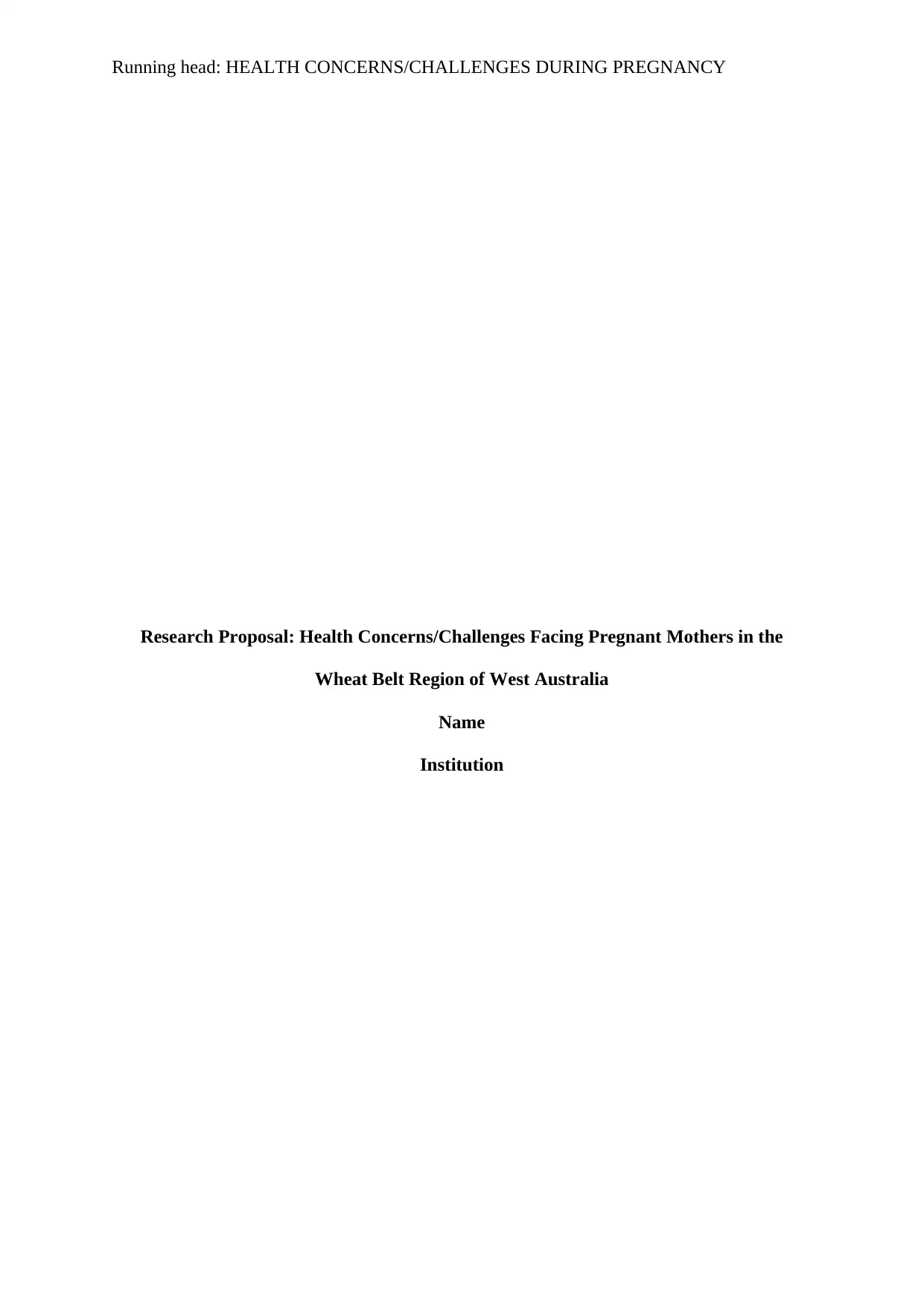
Running head: HEALTH CONCERNS/CHALLENGES DURING PREGNANCY
Research Proposal: Health Concerns/Challenges Facing Pregnant Mothers in the
Wheat Belt Region of West Australia
Name
Institution
Research Proposal: Health Concerns/Challenges Facing Pregnant Mothers in the
Wheat Belt Region of West Australia
Name
Institution
Paraphrase This Document
Need a fresh take? Get an instant paraphrase of this document with our AI Paraphraser
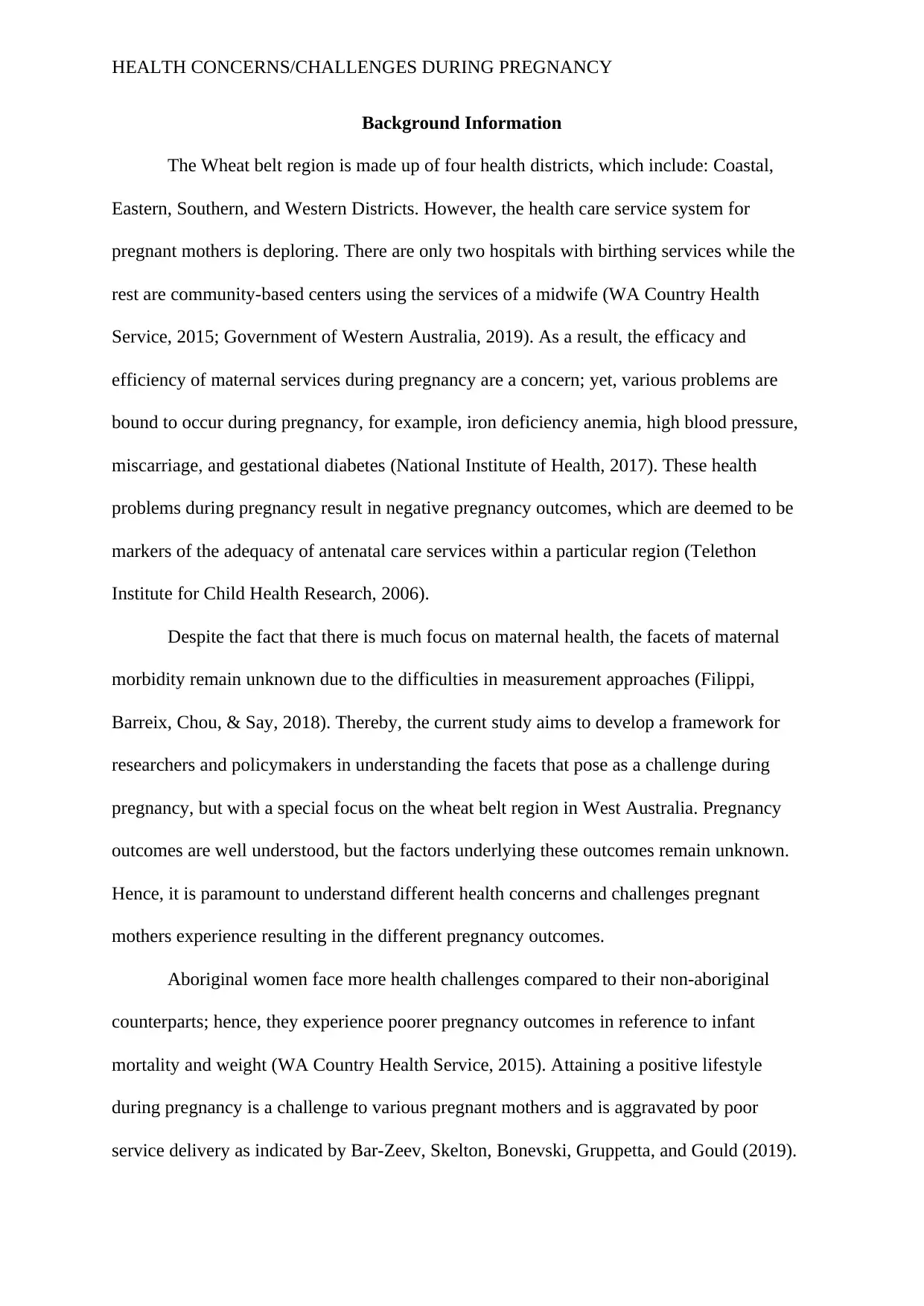
HEALTH CONCERNS/CHALLENGES DURING PREGNANCY
Background Information
The Wheat belt region is made up of four health districts, which include: Coastal,
Eastern, Southern, and Western Districts. However, the health care service system for
pregnant mothers is deploring. There are only two hospitals with birthing services while the
rest are community-based centers using the services of a midwife (WA Country Health
Service, 2015; Government of Western Australia, 2019). As a result, the efficacy and
efficiency of maternal services during pregnancy are a concern; yet, various problems are
bound to occur during pregnancy, for example, iron deficiency anemia, high blood pressure,
miscarriage, and gestational diabetes (National Institute of Health, 2017). These health
problems during pregnancy result in negative pregnancy outcomes, which are deemed to be
markers of the adequacy of antenatal care services within a particular region (Telethon
Institute for Child Health Research, 2006).
Despite the fact that there is much focus on maternal health, the facets of maternal
morbidity remain unknown due to the difficulties in measurement approaches (Filippi,
Barreix, Chou, & Say, 2018). Thereby, the current study aims to develop a framework for
researchers and policymakers in understanding the facets that pose as a challenge during
pregnancy, but with a special focus on the wheat belt region in West Australia. Pregnancy
outcomes are well understood, but the factors underlying these outcomes remain unknown.
Hence, it is paramount to understand different health concerns and challenges pregnant
mothers experience resulting in the different pregnancy outcomes.
Aboriginal women face more health challenges compared to their non-aboriginal
counterparts; hence, they experience poorer pregnancy outcomes in reference to infant
mortality and weight (WA Country Health Service, 2015). Attaining a positive lifestyle
during pregnancy is a challenge to various pregnant mothers and is aggravated by poor
service delivery as indicated by Bar-Zeev, Skelton, Bonevski, Gruppetta, and Gould (2019).
Background Information
The Wheat belt region is made up of four health districts, which include: Coastal,
Eastern, Southern, and Western Districts. However, the health care service system for
pregnant mothers is deploring. There are only two hospitals with birthing services while the
rest are community-based centers using the services of a midwife (WA Country Health
Service, 2015; Government of Western Australia, 2019). As a result, the efficacy and
efficiency of maternal services during pregnancy are a concern; yet, various problems are
bound to occur during pregnancy, for example, iron deficiency anemia, high blood pressure,
miscarriage, and gestational diabetes (National Institute of Health, 2017). These health
problems during pregnancy result in negative pregnancy outcomes, which are deemed to be
markers of the adequacy of antenatal care services within a particular region (Telethon
Institute for Child Health Research, 2006).
Despite the fact that there is much focus on maternal health, the facets of maternal
morbidity remain unknown due to the difficulties in measurement approaches (Filippi,
Barreix, Chou, & Say, 2018). Thereby, the current study aims to develop a framework for
researchers and policymakers in understanding the facets that pose as a challenge during
pregnancy, but with a special focus on the wheat belt region in West Australia. Pregnancy
outcomes are well understood, but the factors underlying these outcomes remain unknown.
Hence, it is paramount to understand different health concerns and challenges pregnant
mothers experience resulting in the different pregnancy outcomes.
Aboriginal women face more health challenges compared to their non-aboriginal
counterparts; hence, they experience poorer pregnancy outcomes in reference to infant
mortality and weight (WA Country Health Service, 2015). Attaining a positive lifestyle
during pregnancy is a challenge to various pregnant mothers and is aggravated by poor
service delivery as indicated by Bar-Zeev, Skelton, Bonevski, Gruppetta, and Gould (2019).
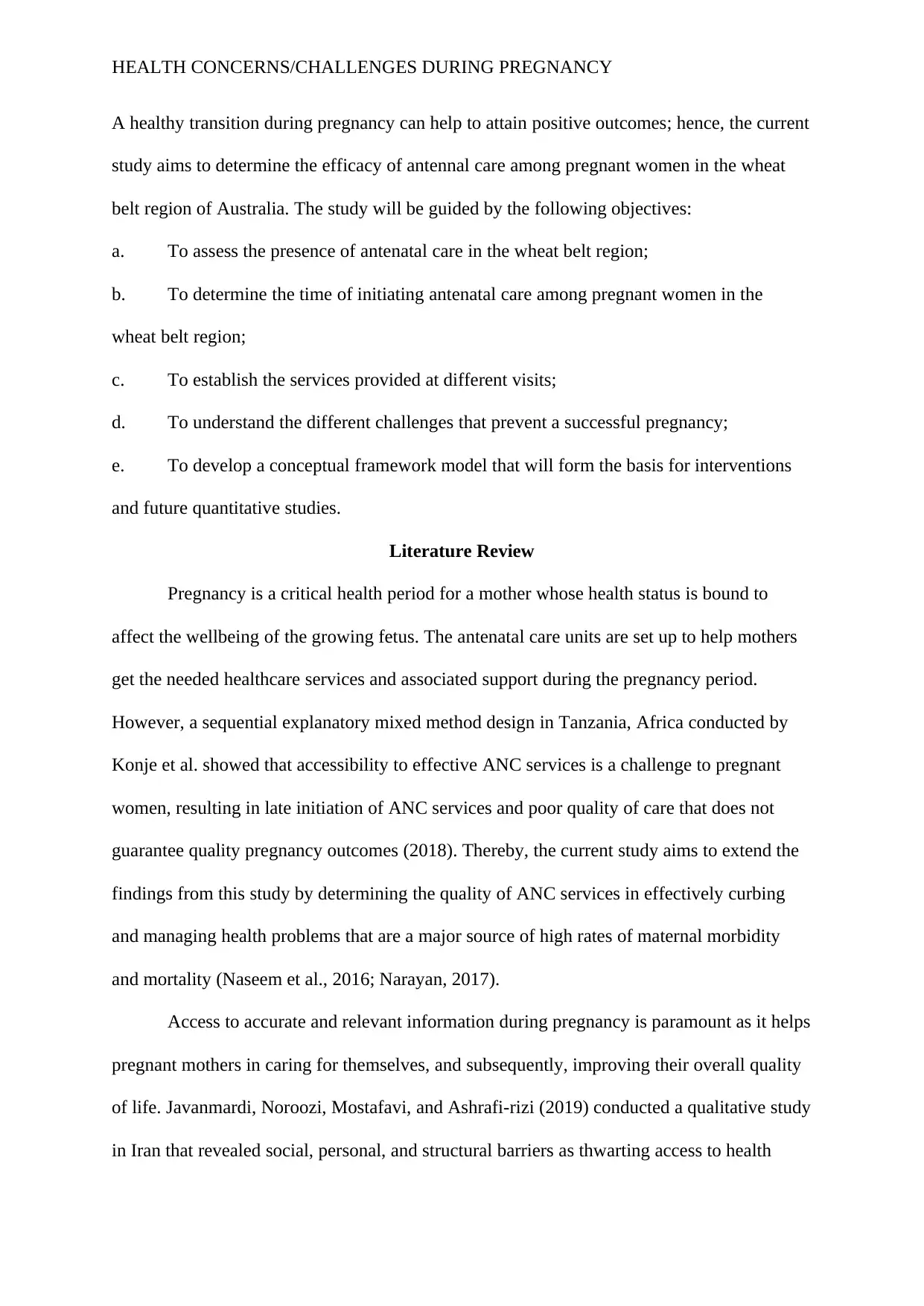
HEALTH CONCERNS/CHALLENGES DURING PREGNANCY
A healthy transition during pregnancy can help to attain positive outcomes; hence, the current
study aims to determine the efficacy of antennal care among pregnant women in the wheat
belt region of Australia. The study will be guided by the following objectives:
a. To assess the presence of antenatal care in the wheat belt region;
b. To determine the time of initiating antenatal care among pregnant women in the
wheat belt region;
c. To establish the services provided at different visits;
d. To understand the different challenges that prevent a successful pregnancy;
e. To develop a conceptual framework model that will form the basis for interventions
and future quantitative studies.
Literature Review
Pregnancy is a critical health period for a mother whose health status is bound to
affect the wellbeing of the growing fetus. The antenatal care units are set up to help mothers
get the needed healthcare services and associated support during the pregnancy period.
However, a sequential explanatory mixed method design in Tanzania, Africa conducted by
Konje et al. showed that accessibility to effective ANC services is a challenge to pregnant
women, resulting in late initiation of ANC services and poor quality of care that does not
guarantee quality pregnancy outcomes (2018). Thereby, the current study aims to extend the
findings from this study by determining the quality of ANC services in effectively curbing
and managing health problems that are a major source of high rates of maternal morbidity
and mortality (Naseem et al., 2016; Narayan, 2017).
Access to accurate and relevant information during pregnancy is paramount as it helps
pregnant mothers in caring for themselves, and subsequently, improving their overall quality
of life. Javanmardi, Noroozi, Mostafavi, and Ashrafi-rizi (2019) conducted a qualitative study
in Iran that revealed social, personal, and structural barriers as thwarting access to health
A healthy transition during pregnancy can help to attain positive outcomes; hence, the current
study aims to determine the efficacy of antennal care among pregnant women in the wheat
belt region of Australia. The study will be guided by the following objectives:
a. To assess the presence of antenatal care in the wheat belt region;
b. To determine the time of initiating antenatal care among pregnant women in the
wheat belt region;
c. To establish the services provided at different visits;
d. To understand the different challenges that prevent a successful pregnancy;
e. To develop a conceptual framework model that will form the basis for interventions
and future quantitative studies.
Literature Review
Pregnancy is a critical health period for a mother whose health status is bound to
affect the wellbeing of the growing fetus. The antenatal care units are set up to help mothers
get the needed healthcare services and associated support during the pregnancy period.
However, a sequential explanatory mixed method design in Tanzania, Africa conducted by
Konje et al. showed that accessibility to effective ANC services is a challenge to pregnant
women, resulting in late initiation of ANC services and poor quality of care that does not
guarantee quality pregnancy outcomes (2018). Thereby, the current study aims to extend the
findings from this study by determining the quality of ANC services in effectively curbing
and managing health problems that are a major source of high rates of maternal morbidity
and mortality (Naseem et al., 2016; Narayan, 2017).
Access to accurate and relevant information during pregnancy is paramount as it helps
pregnant mothers in caring for themselves, and subsequently, improving their overall quality
of life. Javanmardi, Noroozi, Mostafavi, and Ashrafi-rizi (2019) conducted a qualitative study
in Iran that revealed social, personal, and structural barriers as thwarting access to health
⊘ This is a preview!⊘
Do you want full access?
Subscribe today to unlock all pages.

Trusted by 1+ million students worldwide
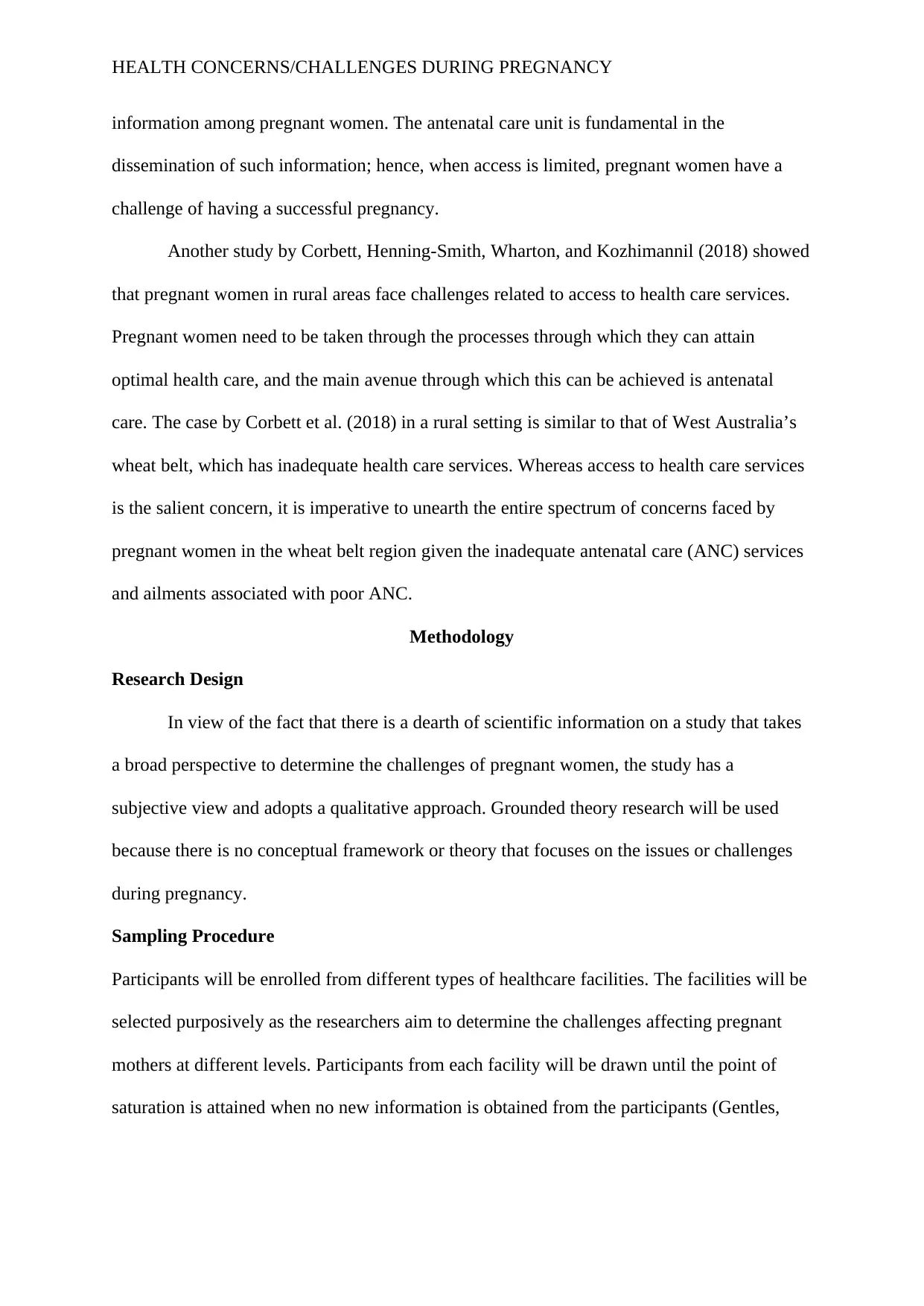
HEALTH CONCERNS/CHALLENGES DURING PREGNANCY
information among pregnant women. The antenatal care unit is fundamental in the
dissemination of such information; hence, when access is limited, pregnant women have a
challenge of having a successful pregnancy.
Another study by Corbett, Henning-Smith, Wharton, and Kozhimannil (2018) showed
that pregnant women in rural areas face challenges related to access to health care services.
Pregnant women need to be taken through the processes through which they can attain
optimal health care, and the main avenue through which this can be achieved is antenatal
care. The case by Corbett et al. (2018) in a rural setting is similar to that of West Australia’s
wheat belt, which has inadequate health care services. Whereas access to health care services
is the salient concern, it is imperative to unearth the entire spectrum of concerns faced by
pregnant women in the wheat belt region given the inadequate antenatal care (ANC) services
and ailments associated with poor ANC.
Methodology
Research Design
In view of the fact that there is a dearth of scientific information on a study that takes
a broad perspective to determine the challenges of pregnant women, the study has a
subjective view and adopts a qualitative approach. Grounded theory research will be used
because there is no conceptual framework or theory that focuses on the issues or challenges
during pregnancy.
Sampling Procedure
Participants will be enrolled from different types of healthcare facilities. The facilities will be
selected purposively as the researchers aim to determine the challenges affecting pregnant
mothers at different levels. Participants from each facility will be drawn until the point of
saturation is attained when no new information is obtained from the participants (Gentles,
information among pregnant women. The antenatal care unit is fundamental in the
dissemination of such information; hence, when access is limited, pregnant women have a
challenge of having a successful pregnancy.
Another study by Corbett, Henning-Smith, Wharton, and Kozhimannil (2018) showed
that pregnant women in rural areas face challenges related to access to health care services.
Pregnant women need to be taken through the processes through which they can attain
optimal health care, and the main avenue through which this can be achieved is antenatal
care. The case by Corbett et al. (2018) in a rural setting is similar to that of West Australia’s
wheat belt, which has inadequate health care services. Whereas access to health care services
is the salient concern, it is imperative to unearth the entire spectrum of concerns faced by
pregnant women in the wheat belt region given the inadequate antenatal care (ANC) services
and ailments associated with poor ANC.
Methodology
Research Design
In view of the fact that there is a dearth of scientific information on a study that takes
a broad perspective to determine the challenges of pregnant women, the study has a
subjective view and adopts a qualitative approach. Grounded theory research will be used
because there is no conceptual framework or theory that focuses on the issues or challenges
during pregnancy.
Sampling Procedure
Participants will be enrolled from different types of healthcare facilities. The facilities will be
selected purposively as the researchers aim to determine the challenges affecting pregnant
mothers at different levels. Participants from each facility will be drawn until the point of
saturation is attained when no new information is obtained from the participants (Gentles,
Paraphrase This Document
Need a fresh take? Get an instant paraphrase of this document with our AI Paraphraser
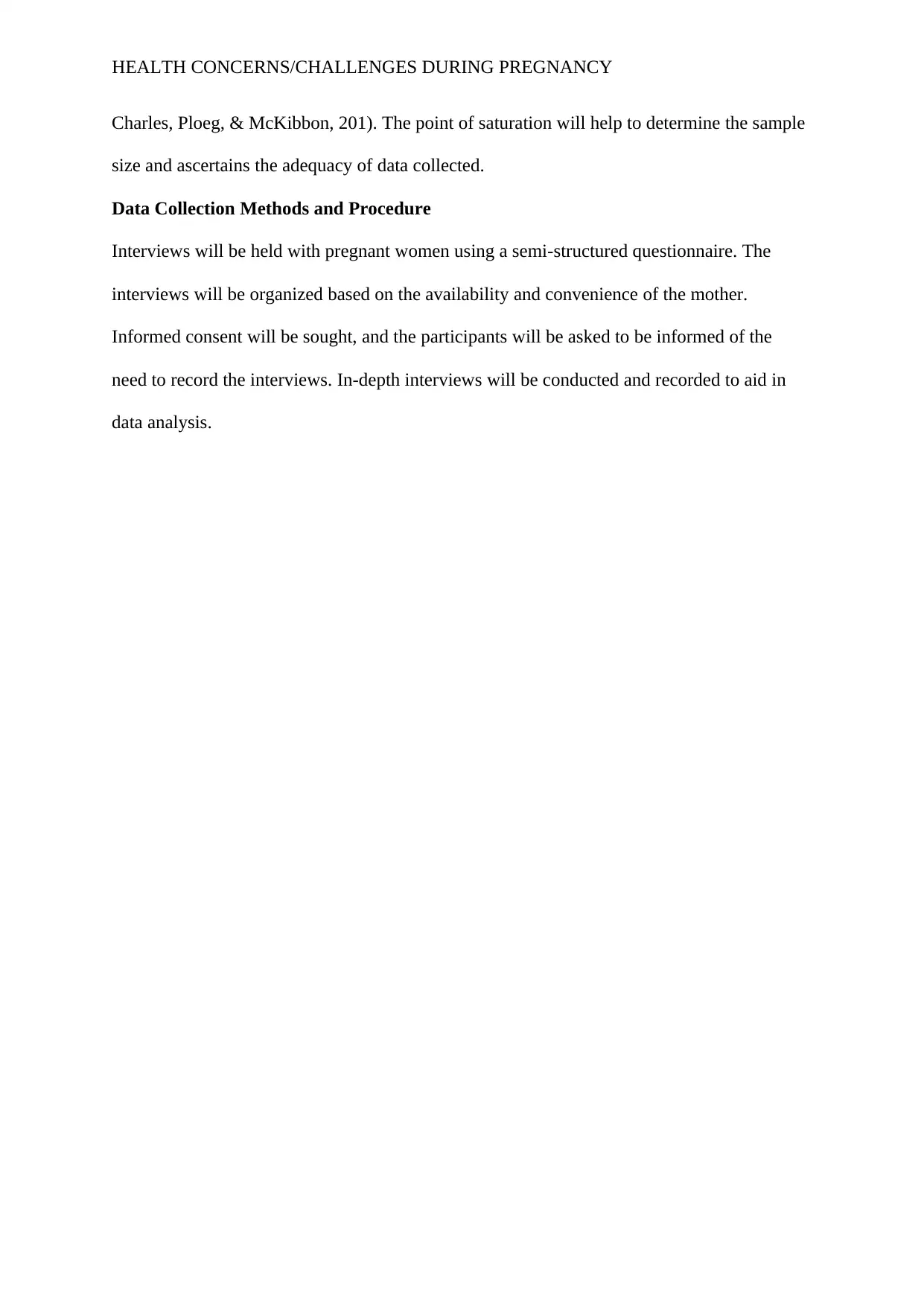
HEALTH CONCERNS/CHALLENGES DURING PREGNANCY
Charles, Ploeg, & McKibbon, 201). The point of saturation will help to determine the sample
size and ascertains the adequacy of data collected.
Data Collection Methods and Procedure
Interviews will be held with pregnant women using a semi-structured questionnaire. The
interviews will be organized based on the availability and convenience of the mother.
Informed consent will be sought, and the participants will be asked to be informed of the
need to record the interviews. In-depth interviews will be conducted and recorded to aid in
data analysis.
Charles, Ploeg, & McKibbon, 201). The point of saturation will help to determine the sample
size and ascertains the adequacy of data collected.
Data Collection Methods and Procedure
Interviews will be held with pregnant women using a semi-structured questionnaire. The
interviews will be organized based on the availability and convenience of the mother.
Informed consent will be sought, and the participants will be asked to be informed of the
need to record the interviews. In-depth interviews will be conducted and recorded to aid in
data analysis.
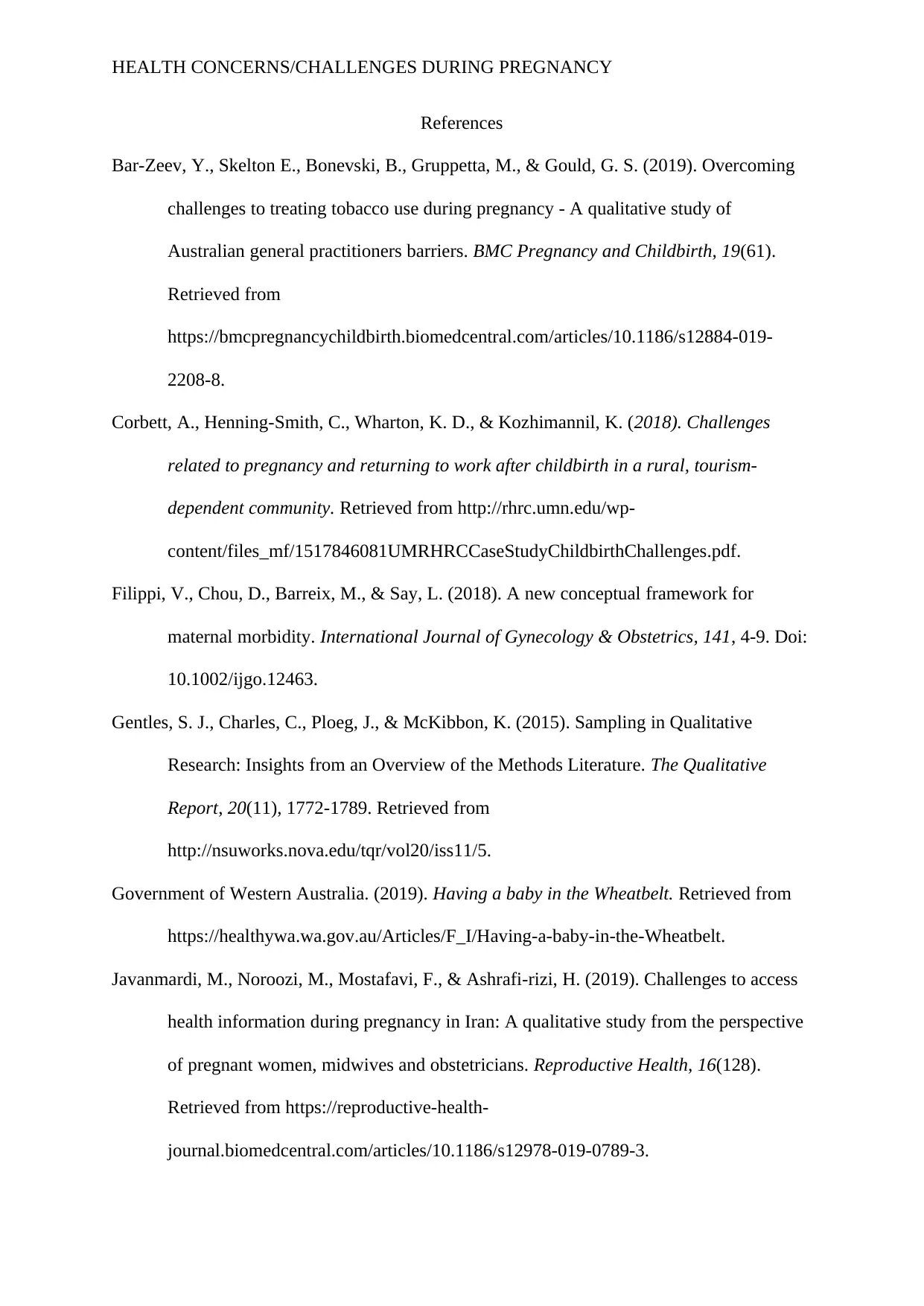
HEALTH CONCERNS/CHALLENGES DURING PREGNANCY
References
Bar-Zeev, Y., Skelton E., Bonevski, B., Gruppetta, M., & Gould, G. S. (2019). Overcoming
challenges to treating tobacco use during pregnancy - A qualitative study of
Australian general practitioners barriers. BMC Pregnancy and Childbirth, 19(61).
Retrieved from
https://bmcpregnancychildbirth.biomedcentral.com/articles/10.1186/s12884-019-
2208-8.
Corbett, A., Henning-Smith, C., Wharton, K. D., & Kozhimannil, K. (2018). Challenges
related to pregnancy and returning to work after childbirth in a rural, tourism-
dependent community. Retrieved from http://rhrc.umn.edu/wp-
content/files_mf/1517846081UMRHRCCaseStudyChildbirthChallenges.pdf.
Filippi, V., Chou, D., Barreix, M., & Say, L. (2018). A new conceptual framework for
maternal morbidity. International Journal of Gynecology & Obstetrics, 141, 4-9. Doi:
10.1002/ijgo.12463.
Gentles, S. J., Charles, C., Ploeg, J., & McKibbon, K. (2015). Sampling in Qualitative
Research: Insights from an Overview of the Methods Literature. The Qualitative
Report, 20(11), 1772-1789. Retrieved from
http://nsuworks.nova.edu/tqr/vol20/iss11/5.
Government of Western Australia. (2019). Having a baby in the Wheatbelt. Retrieved from
https://healthywa.wa.gov.au/Articles/F_I/Having-a-baby-in-the-Wheatbelt.
Javanmardi, M., Noroozi, M., Mostafavi, F., & Ashrafi-rizi, H. (2019). Challenges to access
health information during pregnancy in Iran: A qualitative study from the perspective
of pregnant women, midwives and obstetricians. Reproductive Health, 16(128).
Retrieved from https://reproductive-health-
journal.biomedcentral.com/articles/10.1186/s12978-019-0789-3.
References
Bar-Zeev, Y., Skelton E., Bonevski, B., Gruppetta, M., & Gould, G. S. (2019). Overcoming
challenges to treating tobacco use during pregnancy - A qualitative study of
Australian general practitioners barriers. BMC Pregnancy and Childbirth, 19(61).
Retrieved from
https://bmcpregnancychildbirth.biomedcentral.com/articles/10.1186/s12884-019-
2208-8.
Corbett, A., Henning-Smith, C., Wharton, K. D., & Kozhimannil, K. (2018). Challenges
related to pregnancy and returning to work after childbirth in a rural, tourism-
dependent community. Retrieved from http://rhrc.umn.edu/wp-
content/files_mf/1517846081UMRHRCCaseStudyChildbirthChallenges.pdf.
Filippi, V., Chou, D., Barreix, M., & Say, L. (2018). A new conceptual framework for
maternal morbidity. International Journal of Gynecology & Obstetrics, 141, 4-9. Doi:
10.1002/ijgo.12463.
Gentles, S. J., Charles, C., Ploeg, J., & McKibbon, K. (2015). Sampling in Qualitative
Research: Insights from an Overview of the Methods Literature. The Qualitative
Report, 20(11), 1772-1789. Retrieved from
http://nsuworks.nova.edu/tqr/vol20/iss11/5.
Government of Western Australia. (2019). Having a baby in the Wheatbelt. Retrieved from
https://healthywa.wa.gov.au/Articles/F_I/Having-a-baby-in-the-Wheatbelt.
Javanmardi, M., Noroozi, M., Mostafavi, F., & Ashrafi-rizi, H. (2019). Challenges to access
health information during pregnancy in Iran: A qualitative study from the perspective
of pregnant women, midwives and obstetricians. Reproductive Health, 16(128).
Retrieved from https://reproductive-health-
journal.biomedcentral.com/articles/10.1186/s12978-019-0789-3.
⊘ This is a preview!⊘
Do you want full access?
Subscribe today to unlock all pages.

Trusted by 1+ million students worldwide
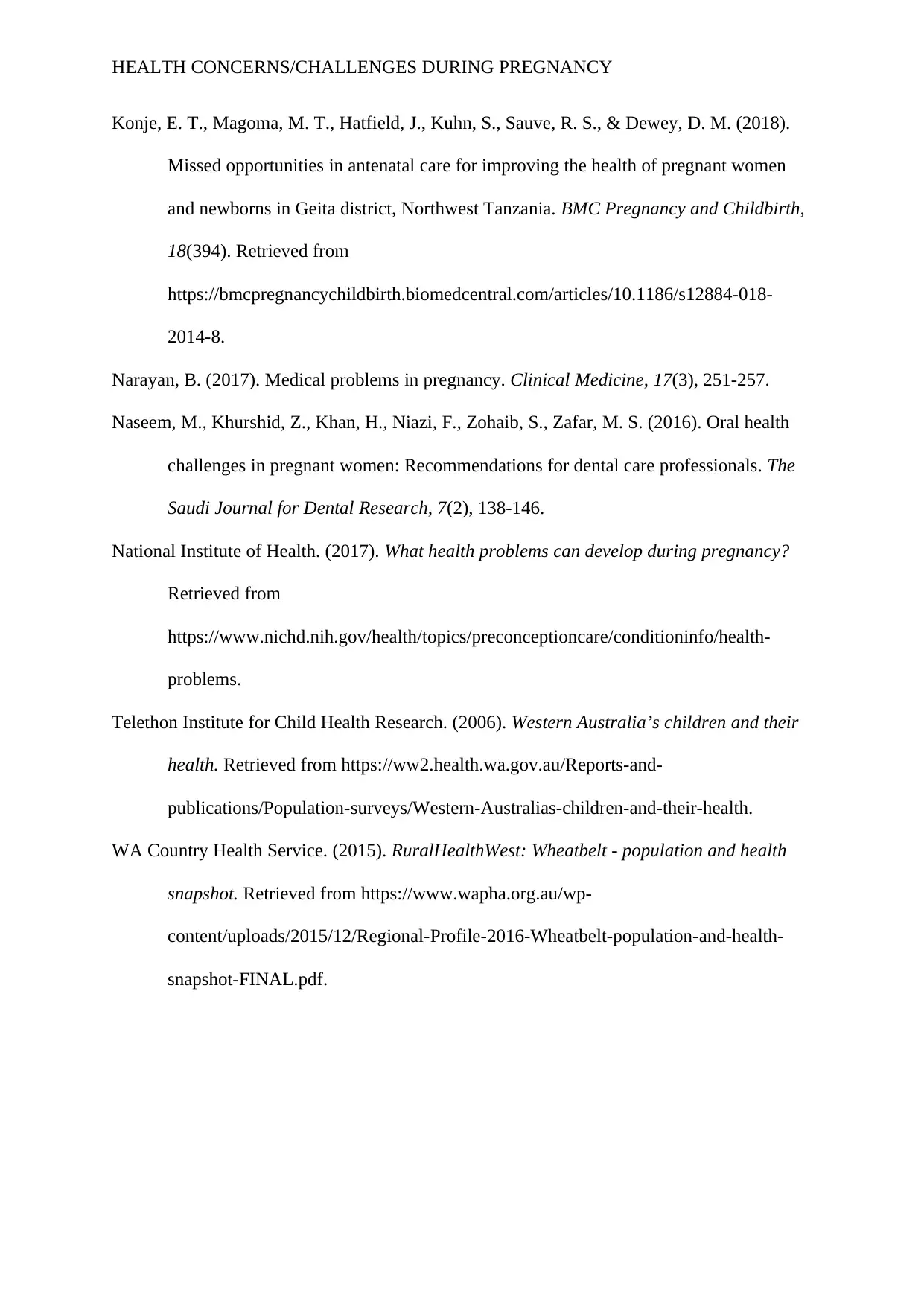
HEALTH CONCERNS/CHALLENGES DURING PREGNANCY
Konje, E. T., Magoma, M. T., Hatfield, J., Kuhn, S., Sauve, R. S., & Dewey, D. M. (2018).
Missed opportunities in antenatal care for improving the health of pregnant women
and newborns in Geita district, Northwest Tanzania. BMC Pregnancy and Childbirth,
18(394). Retrieved from
https://bmcpregnancychildbirth.biomedcentral.com/articles/10.1186/s12884-018-
2014-8.
Narayan, B. (2017). Medical problems in pregnancy. Clinical Medicine, 17(3), 251-257.
Naseem, M., Khurshid, Z., Khan, H., Niazi, F., Zohaib, S., Zafar, M. S. (2016). Oral health
challenges in pregnant women: Recommendations for dental care professionals. The
Saudi Journal for Dental Research, 7(2), 138-146.
National Institute of Health. (2017). What health problems can develop during pregnancy?
Retrieved from
https://www.nichd.nih.gov/health/topics/preconceptioncare/conditioninfo/health-
problems.
Telethon Institute for Child Health Research. (2006). Western Australia’s children and their
health. Retrieved from https://ww2.health.wa.gov.au/Reports-and-
publications/Population-surveys/Western-Australias-children-and-their-health.
WA Country Health Service. (2015). RuralHealthWest: Wheatbelt - population and health
snapshot. Retrieved from https://www.wapha.org.au/wp-
content/uploads/2015/12/Regional-Profile-2016-Wheatbelt-population-and-health-
snapshot-FINAL.pdf.
Konje, E. T., Magoma, M. T., Hatfield, J., Kuhn, S., Sauve, R. S., & Dewey, D. M. (2018).
Missed opportunities in antenatal care for improving the health of pregnant women
and newborns in Geita district, Northwest Tanzania. BMC Pregnancy and Childbirth,
18(394). Retrieved from
https://bmcpregnancychildbirth.biomedcentral.com/articles/10.1186/s12884-018-
2014-8.
Narayan, B. (2017). Medical problems in pregnancy. Clinical Medicine, 17(3), 251-257.
Naseem, M., Khurshid, Z., Khan, H., Niazi, F., Zohaib, S., Zafar, M. S. (2016). Oral health
challenges in pregnant women: Recommendations for dental care professionals. The
Saudi Journal for Dental Research, 7(2), 138-146.
National Institute of Health. (2017). What health problems can develop during pregnancy?
Retrieved from
https://www.nichd.nih.gov/health/topics/preconceptioncare/conditioninfo/health-
problems.
Telethon Institute for Child Health Research. (2006). Western Australia’s children and their
health. Retrieved from https://ww2.health.wa.gov.au/Reports-and-
publications/Population-surveys/Western-Australias-children-and-their-health.
WA Country Health Service. (2015). RuralHealthWest: Wheatbelt - population and health
snapshot. Retrieved from https://www.wapha.org.au/wp-
content/uploads/2015/12/Regional-Profile-2016-Wheatbelt-population-and-health-
snapshot-FINAL.pdf.
1 out of 7
Related Documents
Your All-in-One AI-Powered Toolkit for Academic Success.
+13062052269
info@desklib.com
Available 24*7 on WhatsApp / Email
![[object Object]](/_next/static/media/star-bottom.7253800d.svg)
Unlock your academic potential
Copyright © 2020–2025 A2Z Services. All Rights Reserved. Developed and managed by ZUCOL.




